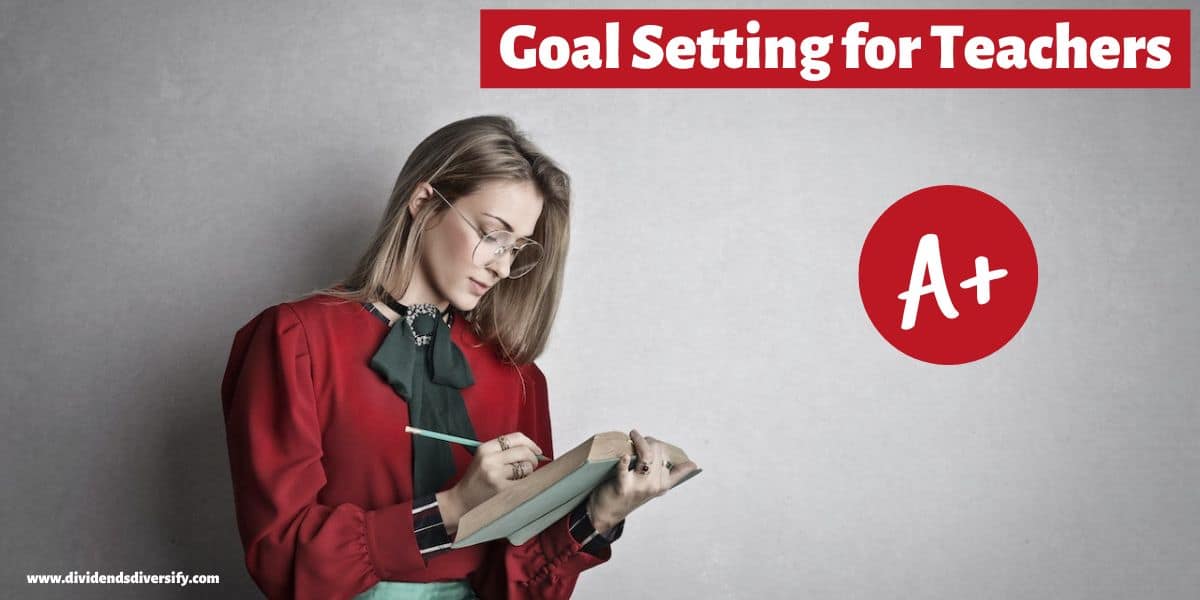SMART Goals Every Teacher Must Set And Achieve
Having spent 5 years of my working life as an educator, I’ve been planning to share my thoughts on the best professional goals for teachers. And now it’s time to do just that.
Thus, no matter what grade or discipline you teach. There is always something to be learned about and for improving your craft each school year.
So, let’s get moving, then you can start learning. And most importantly, your students can reap the rewards…
10 Examples Of Professional Goals For Teachers
My recommended top 10 SMART goals for teachers examples include:
- Focus on student outcomes
- Structure courses for maximum efficiency
- Don’t bore students with endless lectures
- Vary your use of class time
- Solicit student feedback
- Invite an observer to class
- Find a mentor
- Don’t compromise your standards
- Teach a new course
- Collaborate and participate
Next, let’s dig deeper into these teacher professional goals examples.
After that, we will touch on how to make your goals SMART. Also, exactly how to go about achieving your teaching goals.
Shall we…

Disclosure: At no cost to you, I may get commissions for purchases made through links in this post.
1. Focus On Student Outcomes
No matter what you do, it’s always a good idea to start with your long-term objectives in mind. When it comes to teaching that means getting laser-focused on student outcomes.
Thus, ask yourself what your students should accomplish after they have completed your course.
It may be the basics. Such as improved reading or math skills.
Or, more lofty professional outcomes. For example, getting them prepared for college, a career, or graduate-level coursework in the discipline you teach.
Only you and your school’s administrators can decide what the outcome or outcomes should be.
But, decide you must. Because it’s the first in our list of SMART goals for teachers.
Next up…
2. Structure Courses For Maximum Efficiency
Yes, I understand your pain. Simply put, teaching is hard work.
If you are like me, your friends and family think you have an easy job. Conversely, we know it’s not.
Because preparing to teach, and teaching in the classroom is demanding. Since it takes a lot of energy to lead effectively and run your classes at a high level.
As a result, look for every possible way to be more efficient. Without compromising quality.
For example, I found great benefits in making my courses “evergreen”. This means each time I taught a repeating course, the material still applied.
I simply had to pull out my course binder. Refresh my mind on the material. Do some minor updates, and go.
Yes. You should look for ways to fine-tune your courses and make them better. One of my academic mentors used to tell me “always look to turn silver into gold”.
But don’t try to continually “reinvent the wheel” every time you repeat a course. You will just burn yourself out.
3. Don’t Bore Students With Endless Lectures
In the classroom, students have a very short attention span. So, be careful of spending too much time in the front room.
Because talking for long stretches doesn’t promote a good learning environment.
After the first 5 minutes, your students learn to tune it out. The same can be said for babbling on using an endless set of slides on the overhead projector.
On the other hand, when you do decide to lecture, be sure to deliver it with excellent communication skills to engage the class. For best results, you may like this online…
Course on Effective and Authentic Communication
Next, using your time wisely with students brings us to another one of today’s professional goals for teachers…
4. Vary Your Use Of Class Time
Most of my classes were in the evening spanning 3 plus hours. So, it was important to constantly keep the activities fresh during class to keep students engaged.
On the other hand, your classes may be shorter. And during a part of the day when students are more alert. If so, that’s great.
Either way, it’s one of many excellent goals to achieve. Specifically, a variety of in-class activities.
For example, here is one way I would handle one hour of classroom management:
- 15 minutes: A mini-lecture on the topic
- 20 minutes: Group exercise reinforcing the concepts
- 15 minutes: Individual in-class homework on the topic
- 10 minutes: Recap the topic’s key points
I would follow this with a 10-minute break. Then repeat a similar process in the subsequent hours.
To develop and set well-rounded goals, you must continually seek and assess feedback on your performance. And the next 3 objectives for a teacher cover this important activity…

5. Solicit Student Feedback
Throughout a class session and during the entirety of a course, I suggest you constantly seek student feedback. Doing so in a variety of ways.
For example, here are some methods to solicit feedback:
First of all, it can be as simple as reading facial expressions when you are in front of the room.
Furthermore, it can be as casual as engaging with students before and after class. To see what’s on their minds.
Or, feedback can be as formal as a written survey midway through the semester, quarter, term, or whatever your school calls it.
6. Invite An Observer To Class
Sometimes it’s hard to evaluate yourself while you are engaged in the act of teaching.
Also, student feedback needs to be viewed with an objective eye. Just because a student says an exam was unfair. That doesn’t mean it was.
So, consider inviting an observer to audit your class as one of your goals. Perhaps a colleague would welcome the opportunity.
It is a great way to get a fresh perspective on how you are doing.
More importantly, learn how you can improve. And take your career to the next level as a teacher.
7. Find A Mentor
Having a mentor is another way to get honest feedback.
By finding someone who has taught in your field, you can learn from their successes and failures. Furthermore, how they rebounded from mistakes and tough situations with students.
As a result, be sure to learn from other professionals in your field. After all, you’re a teacher. You understand the importance of learning.
8. Don’t Compromise Your Standards
Next, it’s a good idea to continually evaluate your personal and professional standards. Those you choose for yourself and for your courses.
Are they in alignment with desired student outcomes? Do they meet the need of the institution you are teaching for?
Specifically, ensure the standards you have set for yourself are reasonable and appropriate. Then, do your best not to compromise them.
Because there will be pressure to do so. Outside of the best students in your classes, there will always be pressure from some to do less than is expected. And do so for high grades.
So, stay true to yourself. And stick with your standards. It’s important for the integrity of the educational process.
9. Teach A New Course
Stretch yourself, and your abilities. Most importantly, continue to learn by teaching a new course.
Perhaps something slightly removed from your specific area of expertise. Or, a subject you have a deep interest in and a passion for.
10. Collaborate And Participate
Go out of your way to get involved at your school. Join a committee. Attend faculty meetings. Participate in student events.
These are great ways to get to know students, colleagues, and the administration. Making you feel more like a part of the campus and academic community. No matter how large it is, or how small.
Okay. That’s my take on some of the best examples of professional goals for teachers.
Next, I would like to touch on a couple of closely related topics…
How To Set SMART Goals For Teachers
After choosing your goals from today’s suggested list. Write them down and create SMART goals.
We have a more in-depth article about SMART goal setting. And I highly recommend you study it before setting your goals.
In brief, SMART is an acronym. And A SMART goal simply has 5 elements. They are…
Specific. Be as detailed as possible on exactly what you want to accomplish.
Measurable. Determine how you will measure progress and completion of your goal.
Achievable. Don’t waste time on a goal if realistically it’s not achievable.
Relevant. Each teacher goal example selected should be appropriate for your situation.
Time-bound. Make yourself a deadline for completion. Doing so will build commitment and a sense of urgency.
Speaking of time-bound deadlines…
Short, Mid, And Long-Term Professional Goals For Teachers
Make some of your goals short-term. They are to be completed within one year.
Other goals should be medium-term in duration. Targeting completion within 1-5 years.
Furthermore, set some long-term goals. They are an important aspect of your career planning. These goals will take more than 5 years to complete.
Finally, extra big thinkers who are very serious about setting a vision for long-term professional development. They sometimes include 10-year goals as part of planning for the future.
Now, on to goal achievement…
Best Ways To Achieve Your Teaching Goals
Choosing the best professional development goals for teachers. And setting those goals the right way is only the tip of the iceberg.
Because, in the end, there is only one thing that matters. Specifically, achieving those goals you choose.
Follow these steps to achieve your goals for teaching:
- Create the right mindset
- Make a plan
- Take action
- Create an environment for success
- Monitor your progress
Doing so will take SMART goal-setting for teachers to another level of success.
Finally, with a few goals “under your belt” and fully accomplished. Be sure to craft the perfect resume and make it part of your teaching portfolio.
For this, I like to use MyPerfectResume.
Okay. That’s all I have for you today.
So, allow me to conclude with a few parting thoughts…
Wrap-Up: Selecting And Setting Teacher Professional Goals With Examples
Setting and achieving the right goals as a teacher is critical to your success. And important for achieving the student outcomes you and your students desire.
Thus, dig deep into these 10 goals we have discussed. Use the SMART goal-setting system. And get busy using the 5 proven steps to achieve your goals.
Then impress the class. And watch those outstanding course evaluations roll in!
Thanks for reading. If you liked this article. You will enjoy our other posts about…
Setting Goals for Success No Matter What You Do
Good luck. By making it this far, you are a great teacher. I can feel it! 10

Author Bio: Tom Scott founded the consulting and coaching firm Dividends Diversify, LLC. He leverages his expertise and decades of experience in goal setting, relocation assistance, and investing for long-term wealth to help clients reach their full potential.